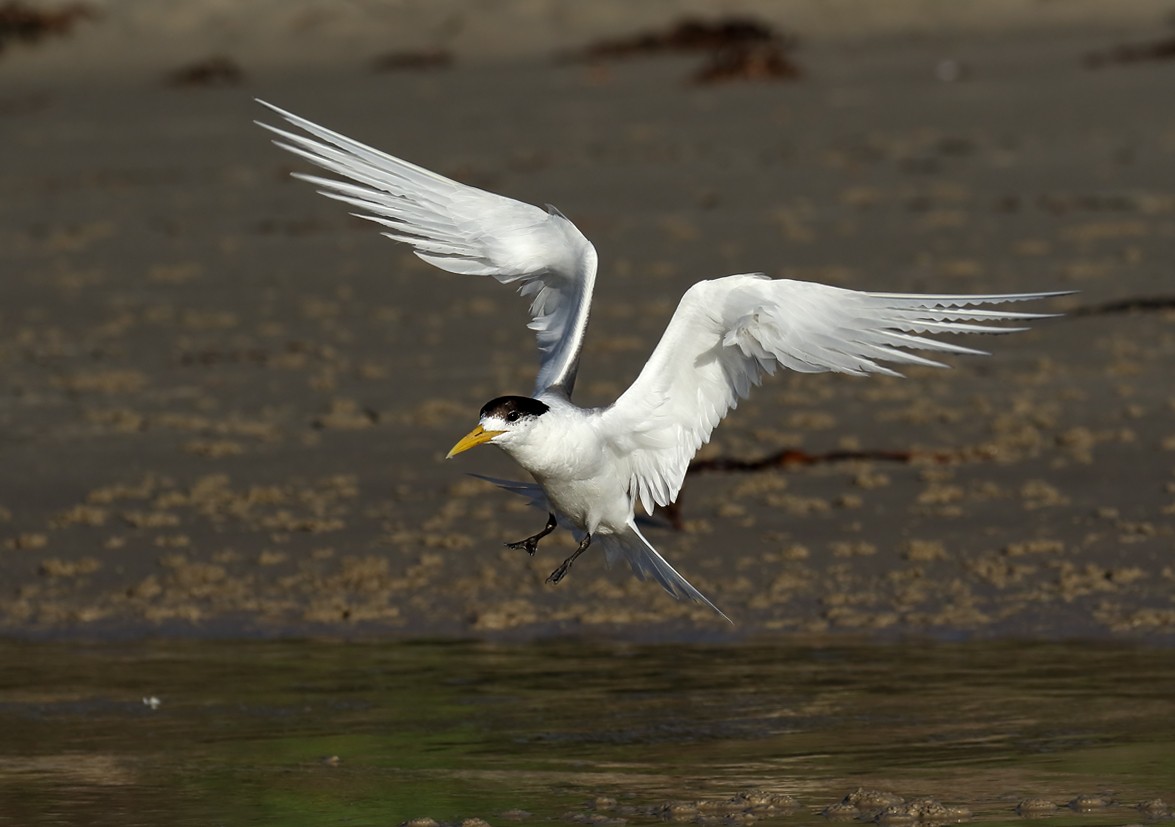Great Crested Tern
A species of Crested terns, Also known as Crested Tern Scientific name : Thalasseus bergii Genus : Crested terns
Great Crested Tern, A species of Crested terns
Also known as:
Crested Tern
Botanical name: Thalasseus bergii
Genus: Crested terns
Content
Description People often ask General Info
Description
The greater crested tern is a large tern with a long (5.4–6.5 cm or 2.1–2.6 in) yellow bill, black legs, and a glossy black crest that is noticeably shaggy at its rear. The breeding adult of the nominate subspecies T. b. bergii is 46–49 cm (18–19.5 in) long, with a 125–130 cm (49–51 in) wing-span; this subspecies weighs 325–397 g (11.4–14.0 oz). The forehead and the underparts are white, the back and inner wings are dusky-grey. In winter, the upperparts plumage wears to a paler grey, and the crown of the head becomes white, merging at the rear into a peppered black crest and mask. The adults of both sexes are identical in appearance, but juvenile birds are distinctive, with a head pattern like the winter adult, and upperparts strongly patterned in grey, brown, and white; the closed wings appear to have dark bars. After moulting, the young terns resemble the adult, but still have a variegated wing pattern with a dark bar on the inner flight feathers. The northern subspecies T. b. velox and T. b. thalassina are in breeding plumage from May to September or October, whereas the relevant period for the two southern African races is from December to April. For T. b. cristata, the moult timing depends on location; birds from Australia and Oceania are in breeding plumage from September to about April, but those in Thailand, China and Sulawesi have this appearance from February to June or July. The royal tern is similar in size to this species, but has a heavier build, broader wings, a paler back and a blunter, more orange bill. The greater crested often associates with the lesser crested tern, but is 25% larger than the latter, with a proportionately longer bill, longer and heavier head, and bulkier body. Lesser crested tern has an orange-tinted bill, and in immature plumage it is much less variegated than greater crested. The greater crested tern is highly vocal, especially at its breeding grounds. The territorial advertising call is a loud, raucous, crow-like kerrak. Other calls include a korrkorrkorr given at the nest by anxious or excited birds, and a hard wep wep in flight. 
Size
41-51 cm (16-20 in)
Life Expectancy
22 years
Nest Placement
Ground
Feeding Habits
Great Crested Tern predominantly consumes fish and occasionally squid, crabs, insects, and baby turtles. These seabirds forage by plunge-diving, showcasing a unique adaptation in hunting aquatic prey.
Habitat
Great Crested Tern typically inhabits tropical and subtropical coastal regions, favoring environments such as offshore islands, coastal spits, and lagoons. The species is often associated with low-lying coral islets, as well as sandy or rocky inlets. It also adapts to artificial habitats like saltpans and sewage works close to shorelines. While nesting primarily on offshore islets, great Crested Tern forages in the shallow waters of lagoons, estuaries, barrier reefs, and open sea. It commonly rests on buoys, rocks, and sandbars, sometimes congregating with other seabirds.
Dite type
Piscivorous
People often ask
General Info
Feeding Habits
Bird food type
Distribution Area
The greater crested tern occurs in tropical and warm temperate coastal parts of the Old World from South Africa around the Indian Ocean to the Pacific and Australia. The subspecies T. b. bergii and T. b. enigma breed in Southern Africa from Namibia to Tanzania, and possibly on islands around Madagascar. There is then a break in the breeding distribution of this species until Somalia and the Red Sea, and another discontinuity further east in southern India. The greater crested tern breeds on many islands in the Indian Ocean including Aldabra and Etoile in the Seychelles, the Chagos Archipelago, and Rodrigues. There are colonies on numerous Pacific islands, including Kiribati, Fiji, Tonga, the Society Islands and the Tuamotus. The nests are located on low‑lying sandy, rocky, or coral islands, sometimes amongst stunted shrubs, often without any shelter at all. When not breeding, the greater crested tern will roost or rest on open shores, less often on boats, pilings, harbour buildings and raised salt mounds in lagoons. It is rarely seen on tidal creeks or inland waters. All populations of greater crested tern disperse after breeding. When Southern African birds leave colonies in Namibia and Western Cape Province, most adults move east to the Indian Ocean coastline of South Africa. Many young birds also travel east, sometimes more than 2,000 km (1,200 mi), but others move northwards along the western coast. T. b. thalassina winters on the east African coast north to Kenya and Somalia and may move as far south as Durban. Populations of T. b. velox breeding from the Persian Gulf eastwards appear to be sedentary or dispersive rather than truly migratory, but those breeding in the Red Sea winter south along the east African coast to Kenya. T. b. cristata mostly stays within 400 km (250 mi) of its colonies, but some birds wander up to around 1,000 km (620 mi). This species has occurred as a vagrant to Hawaii, New Zealand, North Korea, Jordan, and Israel. In India, the Greater crested tern is protected in the PM Sayeed Marine Birds Conservation Reserve. 
Species Status
Not globally threatened.
Scientific Classification
Phylum
Chordates Class
Birds Order
Shorebirds Family
Gulls Genus
Crested terns Species
Great Crested Tern 